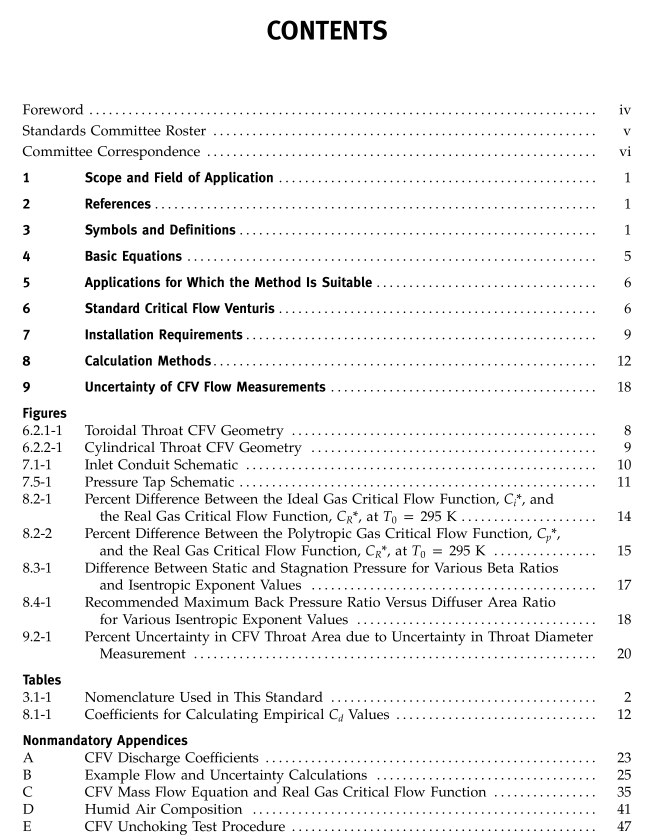ASME MFC-7 pdf download

ASME MFC-7 pdf download Measurement of Gas Flow by Means of Critical Flow Venturis and Critical Flow Nozzles
1 sCOPE AND FIELD OF APPLICATION
This Standard applies only to the steady flow of single-phase gases through critical flow venturis (CFV) of shapesspecified herein [also sometimes referred to as critical flow nozzles (CFN), sonic nozzles, or critical flow venturinozzles]. This Standard applies to CFVs with diverging sections on the downstream side of the throat. When aCFN (no diverging section) is discussed, it is explicitly noted. This Standard specifies the method of use (installationand operating conditions) of CFVs. This Standard also gives information necessary for calculating the mass flowof the gas and its associated uncertainty.
This Standard applies only to CFVs and CFNs in which the flow is critical. Critical flow exists when the massflow through the CFV is the maximum possible for the existing upstream conditions.At critical flow or chokedconditions, the average gas velocity at the CFV throat closely approximates the local sonic velocity.
This Standard specifically applies to cases in which
(a) it can be assumed that there is a large volume upstream of the CFV or upstream of a set of CFVs mountedin a parallel flow arrangement (in a common plenum), thereby achieving higher flow; or
(b) the pipeline upstream of the CFV is of circular cross section with throat to pipe diameter ratio equal to orless than 0.25
REFERENCES
The following publications are referenced in this Standard.The latest edition of ASMEpublications should be used.ASME MFC-3M, Measurement of Fluid Flow in Pipes Using Orifice,Nozzle, and Venturi
ASME PTC 19.5, Flow Measurement
Publisher: The American Society of Mechanical Engineers (ASME),Two Park Avenue, New York,NY 10016-5990(www.asme.org)
ISO 9300:2005,Measurement of gas flow by means of critical flow Venturi nozzles
ISO/IEC Guide 98-3:2008,Uncertainty of measurement—Part 3:Guide to the expression of uncertainty inmeasurement
Publisher: International Organization for Standardization (ISO) Central Secretariat, Chemin de Blandonnet 8, CasePostale 401,1214 Vernier, Geneva,Switzerland (www.iso.org)
NIST Standard Reference Database 23, NIST Reference Fluid Thermodynamic and Transport Properties Database(REFPROP): Version 9.1
Publisher:National Institute of Standards and Technology (NIST),100 Bureau Drive, Stop 1070, Gaithersburg,MD 20899 (www.nist.gov)
3 SYMBOLS AND DEFINITIONS3.1 Symbols and NomenclatureSee Table 3.1-1.
3.2 Definitions
3.2.1 Temperature Measurement
measured gas temperature: temperature of the gas after being irreversibly brought to rest against the temperatureprobe.
stagnation (or total) temperature of a gas: temperature that would exist in the gas if the flowing gas stream werebrought to rest by an isentropic process.
static temperature of a gas: actual bulk temperature of the flowing gas.3.2.2 Critical Flow Venturis
CFV exit plane: surface at the exit of the divergent section.
CFV inlet plane: surface at the entrance of the convergent section.
critical flowo venturi: a flowmeter having a geometrical configuration with a constant curvature convergent sectionto a minimum cross-sectional area (i.e., throat) at which sonic conditions exist followed by a conical divergentsection.
critical (or choked) flow: maximum flow for a particular venturi that can exist for the given upstream conditions; theflow that exists when the ratio of the downstream static pressure, P , to the upstream absolute pressures,Po, issuch that the fluid velocity reaches sonic conditions at the throat. This condition is termed “choked” flow, and theflow is proportional to the inlet stagnation pressure.
critical pressure ratio: the ratio of the absolute static pressure at the CFV throat to the absolute stagnation pressurefor which gas mass flow through the CFV is a maximum.
maximum back pressure ratio: the ratio of the highest absolute CFV exit static pressure to the absolute CFV upstreamstagnation pressure at which the flow becomes critical.
throat: the cross section of the CFV with minimum diameter.
3.2.3 Pressure Measurement
stagnation (or total)pressure of a gas: pressure that would exist in the gas if the flowing gas stream were brought torest by an isentropic process. Only the value of the absolute stagnation pressure is used in this Standard.
static pressure of a gas: the pressure of the flowing gas, which can be measured by connecting a pressure gauge toa wall pressure tap. Only the value of the absolute static pressure is used in this Standard.
coall pressure tap: a hole drilled in the wall of a conduit, the inside edge of which is flush with the inside surface ofthe conduit.









